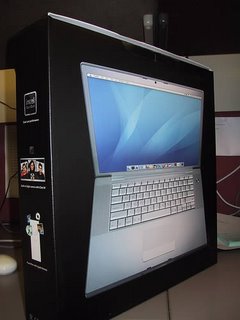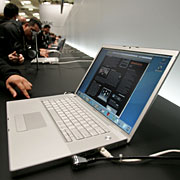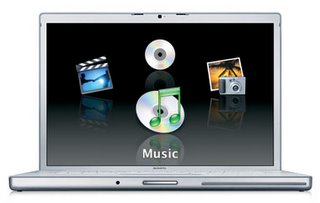Apple MacBook Pro
 The new Apple MacBook Pro ($2,000 and up) looks nearly identical to the company's existing 15-inch PowerBook, but something radical is going on under the hood.
The new Apple MacBook Pro ($2,000 and up) looks nearly identical to the company's existing 15-inch PowerBook, but something radical is going on under the hood.Apple high-end laptops are beautiful, thin and light, clad in scuff-hiding aluminum and crammed with features: Wi-Fi wireless networking, Bluetooth wireless, DVD burning, light-up keys for typing in the dark, stereo speakers, batteries with illuminated "fuel gauges" and more. But the speed of Apple's laptops has only inched forward in recent years, largely because of its processor chips, made by International Business Machines and Freescale.
Apple made the eyebrow-raising decision, therefore, to replace that chip family with chips from another company you may have heard of: Intel.
Changing chip families in a computer is not as simple as changing a CD in your stereo. The entire operating system and every single software program must be rewritten, which can take weeks or months.
But Apple deemed the big transition to be worth the effort. In return, it gets the state of the art in laptop horsepower: Intel's new Core Duo chip, which bears two electronic brains instead of one. By the end of this year, every Macintosh model will receive an Intel brain transplant.
Early this year, Apple put an Intel chip into the iMac; on Tuesday, into the Mac Mini; and this week, the first Mac laptop containing the Intel processor is reaching customers: the MacBook Pro, which measures 15 inches, or 38 centimeters. Why do Mac fans despise the new name? Partly because all those harsh consonants - K, K, P - make the name uglier and harder to say.
Apple calls the MacBook "the finest laptop in the world." In truth, a more accurate description would be "the finest laptop in the world, with a small serving of disappointment on the side."
The one-inch-thick MacBook is only 0.1 inch thinner than the PowerBook, but it somehow feels worlds sleeker and more futuristic. Fit, finish and quality are spectacular. The wireless antenna has been moved, so Wi-Fi reception is much improved. The guts, from the bus (circuitry) to the graphics card, have been substantially accelerated. Battery life is pretty much the same as on the PowerBooks: three to three and a half hours.
Apple calls the MacBook "the finest laptop in the world." In truth, a more accurate description would be "the finest laptop in the world, with a small serving of disappointment on the side."
The one-inch-thick MacBook is only 0.1 inch thinner than the PowerBook, but it somehow feels worlds sleeker and more futuristic. Fit, finish and quality are spectacular. The wireless antenna has been moved, so Wi-Fi reception is much improved. The guts, from the bus (circuitry) to the graphics card, have been substantially accelerated. Battery life is pretty much the same as on the PowerBooks: three to three and a half hours.
 The MacBook trumps its predecessor in five substantial areas. First, the gorgeous 1,440-by-900-pixel screen is much whiter and brighter. At half brightness, it matches the brightest setting of other laptops; at full brightness, it could illuminate a runway.
The MacBook trumps its predecessor in five substantial areas. First, the gorgeous 1,440-by-900-pixel screen is much whiter and brighter. At half brightness, it matches the brightest setting of other laptops; at full brightness, it could illuminate a runway.Second, a tiny video camera is tucked inconspicuously above the screen. It's ideal for taking Web pictures, capturing video or using the iChat program, which lets you conduct smooth, full-screen videoconferences with as many as three other people over the Internet - free.
The third enhancement is a slim finger-length remote control. You can use it to operate the MacBook from across the room. In addition, there's a new power cord, which attaches to the laptop magnetically, so if someone trips on the cord. your $2,000 computer doesn't crash to the floor.
The biggest change of all, though, is in the MacBook's speed. It's nothing like the 4X or 5X speedup measured by Apple's benchmarks. Even so, this machine flies. It starts up fast, programs open fast, iTunes imports CDs fast, iMovie processes high-definition video fast, and Web pages blink onto the screen, fully formed.
Note, though, that all of that speed is available only when you're using programs that have been revised to work with the Intel chip - so-called Universal programs. In that category, you'll find Mac OS X itself; all of the programs that come with the MacBook; more than 900 programs from other companies; and, later this month, Apple's professional programs - Final Cut, Aperture and so on.
Unfortunately, most of the big-name programs, like Microsoft Office and Adobe everything, won't be released in Universal format for quite some time. These older programs still run acceptably on the MacBook, but they run slowly, with pauses here and there.
 But Apple always giveth and taketh away. This time around, Apple hath taken away quite a few PowerBook features. The S-video connector, for high- quality TV playback of movies, is gone. The FireWire 800 connector, for high- speed hard drives, is also missing. The DVD burner is only half as fast as the previous model (4X instead of 8X) and can no longer burn dual-layer DVD discs. Current PC expansion cards don't work or fit in the new narrow-format ExpressCard slot.
But Apple always giveth and taketh away. This time around, Apple hath taken away quite a few PowerBook features. The S-video connector, for high- quality TV playback of movies, is gone. The FireWire 800 connector, for high- speed hard drives, is also missing. The DVD burner is only half as fast as the previous model (4X instead of 8X) and can no longer burn dual-layer DVD discs. Current PC expansion cards don't work or fit in the new narrow-format ExpressCard slot.
Over all, the MacBook Pro is a beautifully engineered machine.
But in so many ways, it is just a forward-thinking laptop. It won't achieve true greatness until the important programs have been rewritten for the Core Duo chip's blazing speed, expansion cards for the new slot are available and wireless Internet is offered by every hotel, bed-and-breakfast and friend's house. Until then, call it the MacBook Po - for Potential.
The biggest change of all, though, is in the MacBook's speed. It's nothing like the 4X or 5X speedup measured by Apple's benchmarks. Even so, this machine flies. It starts up fast, programs open fast, iTunes imports CDs fast, iMovie processes high-definition video fast, and Web pages blink onto the screen, fully formed.
Note, though, that all of that speed is available only when you're using programs that have been revised to work with the Intel chip - so-called Universal programs. In that category, you'll find Mac OS X itself; all of the programs that come with the MacBook; more than 900 programs from other companies; and, later this month, Apple's professional programs - Final Cut, Aperture and so on.
Unfortunately, most of the big-name programs, like Microsoft Office and Adobe everything, won't be released in Universal format for quite some time. These older programs still run acceptably on the MacBook, but they run slowly, with pauses here and there.
 But Apple always giveth and taketh away. This time around, Apple hath taken away quite a few PowerBook features. The S-video connector, for high- quality TV playback of movies, is gone. The FireWire 800 connector, for high- speed hard drives, is also missing. The DVD burner is only half as fast as the previous model (4X instead of 8X) and can no longer burn dual-layer DVD discs. Current PC expansion cards don't work or fit in the new narrow-format ExpressCard slot.
But Apple always giveth and taketh away. This time around, Apple hath taken away quite a few PowerBook features. The S-video connector, for high- quality TV playback of movies, is gone. The FireWire 800 connector, for high- speed hard drives, is also missing. The DVD burner is only half as fast as the previous model (4X instead of 8X) and can no longer burn dual-layer DVD discs. Current PC expansion cards don't work or fit in the new narrow-format ExpressCard slot.Over all, the MacBook Pro is a beautifully engineered machine.
But in so many ways, it is just a forward-thinking laptop. It won't achieve true greatness until the important programs have been rewritten for the Core Duo chip's blazing speed, expansion cards for the new slot are available and wireless Internet is offered by every hotel, bed-and-breakfast and friend's house. Until then, call it the MacBook Po - for Potential.
MacBook Pro
new macbook pro
Apple MacBook Pro
Posted by Anonymous |
7:53 PM
Anonymous |
7:53 PM